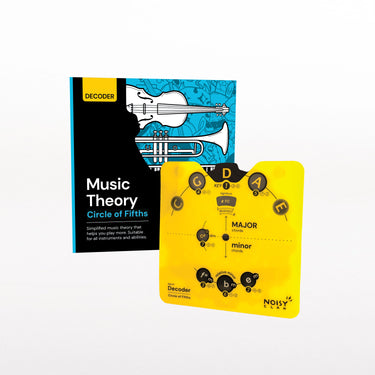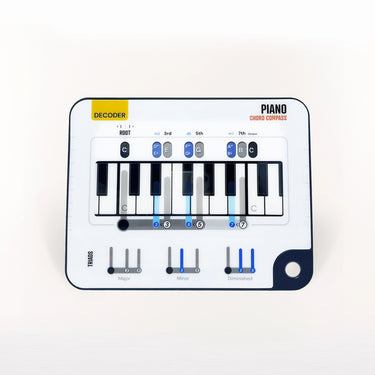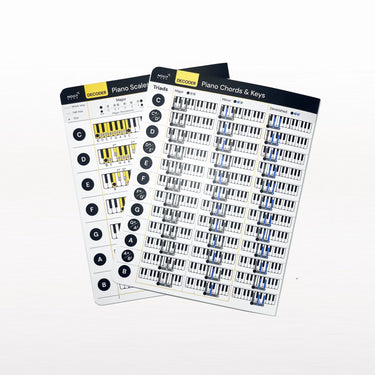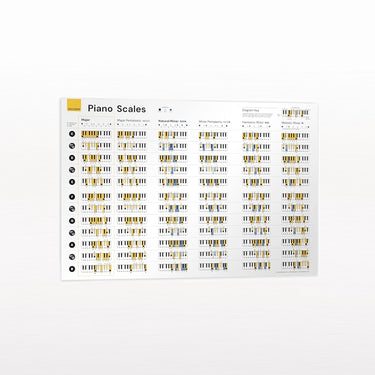
What Scale is shown above? (Answer at bottom)
Introduction: Why the Major Scale is Your Starting Line
If music theory were a treasure map, the major scale would be the “X marks the spot.” This scale is the foundation of nearly every piece of Western music, from pop hits to classical masterpieces. Want to learn how to play piano confidently? Or master piano chords that fuel your favorite songs? It all starts with the major scale.
In this blog, we’ll break down the major scale, its significance, and how tools like the Noisy Clan’s Chord Compass can make learning it a breeze. Plus, we’ll throw in some fun exercises, relatable examples, and maybe even a laugh or two. (Because, honestly, who said learning music had to be boring?)
What Is the Major Scale?
The major scale is a sequence of seven notes that follow a specific pattern of whole steps and half steps. It’s the "happy-go-lucky" scale in music, radiating bright and uplifting vibes.
The pattern? Whole, Whole, Half, Whole, Whole, Whole, Half. Or as we like to say, WWHWWWH—sounds like a sneeze, but it’s music magic!
For example:
-
The C major scale (everyone’s first love): C - D - E - F - G - A - B - C
-
See how it follows the WWHWWWH pattern between notes? That’s the secret sauce.
Why Is the Major Scale Important?
The major scale is the backbone of piano chords and harmony. It’s like a musical skeleton that supports everything else:
-
Chords: The notes of every chord (major, minor, diminished) are pulled directly from scales.
-
Melodies: Your favorite songs? Major scale notes in action.
-
Improvisation: It’s the playground for creativity, even in jazz and pop.
Without the major scale, understanding music theory would be like trying to read a book without learning the alphabet.
The Major Scale and Chord Compass
Noisy Clan’s Chord Compass takes the guesswork out of major scales and chords. Slide to any root note, and it instantly maps out the notes of that scale and corresponding chords.
For instance:
-
Need to build a B major chord? Slide the Chord Compass to the B and it highlights the 1st (B), 3rd (D#), and 5th (F#) notes.
Exercises: Building Your Major Scale Muscles
Beginner Exercise: Play It Simple
-
Choose a starting note (e.g., C).
-
Follow the WWHWWWH pattern to find the rest of the notes.
-
Play them slowly, one at a time, and listen to the happy sound of the scale.
Advanced Exercise: Scale Races
-
Set a metronome to a slow tempo (e.g., 60 BPM).
-
Play the C major scale ascending and descending.
-
Gradually increase the tempo—how fast can you go without missing a note?
Major Scales in Songs
You hear major scales everywhere. Here are some songs where this iconic scale shines:
-
"Do-Re-Mi" (The Sound of Music): The ultimate ode to the major scale. Seriously, just sing along.
-
"Let It Be" (The Beatles): Built around C major, G major, and F major chords—all from the C major scale.
-
"Happy" (Pharrell Williams): A catchy example of the joyful nature of major scales.
Fun Break: Why Did the Piano Get Locked Out of Its House?
It lost its keys! (Hey, we had to sneak in a joke.)
Dive Deeper: Master the Major Scale with the Chord Compass
The Chord Compass isn’t just a tool—it’s your music theory tutor. With its intuitive layout, you’ll:
-
Visualize scales and chords instantly.
-
Avoid theory overwhelm—just turn the wheel and play.
-
Start creating and understanding music faster.
Want a free download to practice scales? Sign up with your email and get exclusive access to all you need for your exercises. It’s the easiest way to learn piano while having fun.
The Science Behind the Major Scale’s Happiness
Ever wonder why the major scale sounds so joyful? Science suggests it’s because of the mathematical simplicity in the relationships between its notes. These pure intervals (like the major third and perfect fifth) resonate harmoniously with our ears.
So, when you play the major scale, you’re not just making music—you’re creating a sonic smile.
Advanced Exercise: Chord Progressions with Major Scales
Want to level up? Create chord progressions using the major scale:
-
Pick a key (e.g., C major).
-
Use the chords built on each scale degree: C (1), Dm (2), Em (3), F (4), G (5), Am (6), Bdim (7).
-
Experiment with progressions like 1-4-5-1 or 2-5-1.
These patterns form the backbone of countless pop, rock, and classical songs.
Why Learn Piano with Noisy Clan?
At Noisy Clan, we believe learning music should be intuitive and enjoyable. Our tools like the Chord Compass help you skip the frustration and dive into the joy of playing music. Whether you’re just starting out or looking to deepen your knowledge, we’ve got you covered. Sign up for our email list and grab our free printable resources to kickstart your piano journey. Start learning piano today! And if, at this point, you cannot live without chords, read more about them here!
Conclusion: Start Your Major Scale Journey Today
The major scale is the foundation of music. It’s where every great pianist starts, and it’s the key to unlocking a deeper understanding of piano chords and music theory. With the Chord Compass and Noisy Clan’s support, you’ll turn theory into practice in no time.
So, what are you waiting for? Play those happy notes, build those chords, and let your piano journey shine bright. Happy practicing! 🎹
(Ps - The Scale at the top is B Major!)















